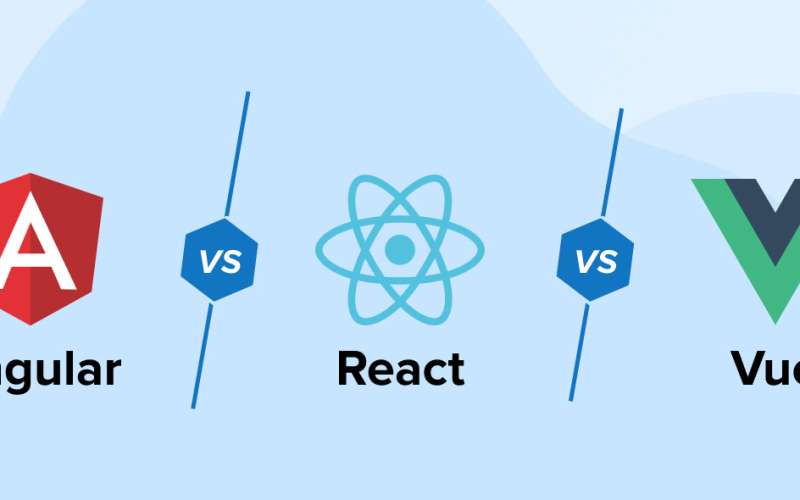React vs. Angular vs. Vue: A Detailed Comparison

Compare React, Angular, and Vue to choose the best JavaScript framework for your project. Learn their features, pros, and use cases.
Introduction
Choosing the right JavaScript framework or library for front-end development is crucial for building scalable and efficient web applications. React, Angular, and Vue are three of the most popular choices, each with its own strengths, use cases, and learning curves. This article provides a detailed comparison to help developers and businesses choose the best tool for their projects.
Overview of React, Angular, and Vue
| Feature | React | Angular | Vue |
|---|---|---|---|
| Type | Library | Framework | Framework |
| Developed by | Meta (Facebook) | Evan You | |
| Initial Release | 2013 | 2010 | 2014 |
| Language | JavaScript (JSX) | TypeScript | JavaScript |
| Architecture | Component-based | Component-based MVC | Component-based |
| Learning Curve | Moderate | Steep | Easy to Moderate |
| Performance | High | Moderate | High |
| State Management | React Context, Redux, Zustand | RxJS, NgRx | Vuex, Pinia |
| Best For | Single Page Applications (SPAs), UI-heavy apps | Enterprise applications, large-scale apps | Progressive web apps, lightweight applications |
| Popular Use Cases | Facebook, Instagram, Airbnb | Google products, IBM, Microsoft | Alibaba, Xiaomi, GitLab |
React: The Flexible Library
What is React?
React is a JavaScript library developed by Meta (formerly Facebook) for building interactive user interfaces. It follows a component-based architecture and uses JSX to create dynamic UIs efficiently.
Key Features of React
✔️ Virtual DOM for efficient rendering
✔️ Component-based architecture
✔️ Hooks for managing state and side effects
✔️ One-way data binding for predictable UI updates
✔️ Rich ecosystem with React Router, Redux, Next.js, and more
Advantages of React
✅ Easy to integrate with other frameworks and libraries
✅ Large developer community and extensive support
✅ Performance optimization using Virtual DOM
✅ Reusable components improve maintainability
Disadvantages of React
❌ Requires additional libraries for state management (e.g., Redux)
❌ JSX syntax may be confusing for beginners
When to Use React?
- When building dynamic and interactive UIs
- When working on single-page applications (SPAs)
- When scalability and reusability of components are priorities
Angular: The Robust Framework
What is Angular?
Angular is a full-fledged front-end framework developed by Google. It follows the Model-View-Controller (MVC) architecture and is designed for large-scale enterprise applications.
Key Features of Angular
✔️ Two-way data binding for automatic UI updates
✔️ Dependency Injection (DI) for modular development
✔️ RxJS for reactive programming
✔️ Built-in routing and state management
✔️ Comprehensive CLI for project management
Advantages of Angular
✅ Strong scalability for enterprise applications
✅ In-built features (routing, forms, validation) reduce dependency on external libraries
✅ Strict TypeScript support enhances code quality and debugging
✅ Excellent long-term support from Google
Disadvantages of Angular
❌ Steep learning curve due to complex concepts (RxJS, DI, TypeScript)
❌ Slower performance compared to React and Vue for small-scale applications
When to Use Angular?
- When building large-scale enterprise applications
- When developing progressive web applications (PWAs)
- When working on applications requiring robust security and maintainability
Vue: The Lightweight Framework
What is Vue?
Vue is a progressive JavaScript framework developed by Evan You. It is lightweight, easy to learn, and focuses on simplicity and flexibility.
Key Features of Vue
✔️ Reactive and component-based architecture
✔️ Two-way data binding for seamless UI updates
✔️ Vuex and Pinia for state management
✔️ Simple integration with existing projects
✔️ Virtual DOM for high performance
Advantages of Vue
✅ Easy to learn and integrate into projects
✅ Lightweight and fast compared to Angular
✅ Flexible structure allows gradual adoption
✅ Strong documentation and growing community
Disadvantages of Vue
❌ Smaller ecosystem compared to React and Angular
❌ Limited support for large-scale applications
When to Use Vue?
- When building lightweight and fast applications
- When working on progressive web applications (PWAs)
- When simple syntax and easy learning curve are priorities
Which One Should You Choose?
| If you need... | Choose |
|---|---|
| A lightweight, flexible library for UI development | React |
| A full-fledged framework for large applications | Angular |
| An easy-to-learn framework for quick development | Vue |
- Choose React if you need a scalable and flexible front-end library for interactive UIs.
- Choose Angular if you need a powerful, full-featured framework for complex applications.
- Choose Vue if you need a lightweight, beginner-friendly framework for smaller projects.
Conclusion & Future Trends
All three frameworks—React, Angular, and Vue—continue to evolve with new updates and features. While React dominates the industry due to its flexibility, Angular remains the preferred choice for enterprise solutions, and Vue is gaining popularity for its simplicity. Future advancements in server-side rendering (SSR), AI-driven UI components, and Web3 integration will further shape the landscape of front-end development.
Keywords
React vs Angular vs Vue, JavaScript frameworks, front-end development, React advantages, Angular vs Vue, Vue.js comparison, best framework for web development, UI frameworks, web app development.



Write A Comment
No Comments